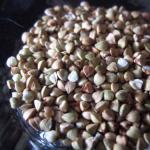
Strong drinks of Greece. Tsipouro – Greek grape vodka. History of Greek anise vodka Ouzo
The national pride and heritage of Greece, vodka “Oyzo” in Russian transliteration sounds like Ouzo. The alcoholic drink “Ouzo” is legally recognized as national and can only be produced in Greece. Let's find out more about it.
In the article:
History of Greek anise vodka Ouzo
There are two versions of the origin of the name of the national drink of Hellas. The first and most reliable - according to the Greek name of the mandatory component of this vodka - anise. The second, dubious, comes from the Turkish word “uzum”, which means grapes or bunch of grapes. Although, why would the Greeks call their native anise vodka “Ouzo” with a Turkish word?
The question of who, when and where the Greek drink Ouzo was first made remains open, especially since drinks similar in technology and results are successfully produced by the countries of the Balkan Peninsula neighboring Greece. In Turkey it is “Arak”, in Bulgaria “Mastic”. This is not a complete list of alcoholic drinks that are similar in composition and taste.
But the Greeks want to believe that Ouzo is the drink of the Olympian gods, along with. The Olympians did not write chronicles, only myths remained, but there was not a word about “Uzo”. They also say that this alcoholic drink began to be made during the Byzantine Empire, but these are just rumors. It is more likely that the preparation of this drink in Greece was started by the Turks during the Ottoman Empire. It is very similar to the Turkish “Crayfish” or “Arak”.
Its production is most widespread on the islands of Lesvos, Kalamata and Tyrnavos in small distilleries, sometimes located right among the vineyards. Greek anise vodka, prepared in private small distilleries, is valued much higher than an industrially produced drink. This is understandable; ancient technology is followed here, according to which the starting material for preparing the drink is exclusively grape pomace and herbs.
Production technology of modern Oyzo vodka
 It must be said right away that the entire technological process for the production of Greek vodka “OYZO” is not particularly complicated. Step by step it looks like this:
It must be said right away that the entire technological process for the production of Greek vodka “OYZO” is not particularly complicated. Step by step it looks like this:
- The mash is made from grape marc.
- It is combined with ethyl alcohol with a strength of 40°; according to the law, an industrially prepared drink must contain at least 20% grape rectified.
- Herbs and plant seeds are immersed in this mixture: anise seed is required, and then the set of herbs is arbitrary, and each manufacturer has its own. This could be coriander, mastic tree bark, chamomile, fennel, almonds, cloves, etc. This whole mass is infused for several months. Each manufacturer decides exactly how much at its own discretion. That is why you will not find the Ouzo drink with the same taste.
- Then all this is subjected to re-distillation: at private owners - in ancient copper stills, at modern large enterprises - in huge stationary distillation apparatuses.
- The strength of the original drink should not exceed 50°.
How to drink Ouzo vodka
We already know what Greek vodka is called and how it is made. It remains to cover an important question - how to drink “Ouzo”?
 In Greece there are taverns called " uzeri", where you will only be served this vodka as alcohol, but there are a great variety of snacks. Mainly seafood and the famous Greek salad, which is called “horiatiki” here.
In Greece there are taverns called " uzeri", where you will only be served this vodka as alcohol, but there are a great variety of snacks. Mainly seafood and the famous Greek salad, which is called “horiatiki” here.
They drink Ouzo in shot glasses in its pure form, or diluted with water in a 1:1 ratio. When diluted, it becomes cloudy, but it becomes much softer in taste. This way you can better sense the complexity of the flavor composition. Undiluted, it burns. This vodka is very insidious. You can drink it and feel completely sober, but when you decide to get up and walk, it turns out that you don’t have much control over your body. You should know this feature so as not to get into trouble.
Vodka UZO PLOMARI
Like any alcohol that has received national status, Ouzo is considered an elite alcohol on the world market. For that reason alone it's worth trying. It’s not cheap here - a 0.2 liter bottle costs 550 rubles. In the homeland of the drink, the price is several times cheaper.
Collectors of taste sensations will not deny themselves the pleasure of getting to know the legendary Greek vodka. You may ask, why legendary? Because the Greeks are the coolest producers of myths and legends.
The Japanese have sake, the Koreans have soju, Indonesia and Bali have tuak. In Greece, ouzo is synonymous with folk spirit.
But this name itself, “ouzo,” came into use quite late, only in the second half of the 19th century.
This exclusively Greek drink owes its birth to traditions rooted in the thousand-year history of the production of strong alcoholic beverages, which appeared in Ancient Egypt and Persia.
And the story of his birth itself is surrounded by an aura of mystery and mysticism. Let's try to lift the veil of secrecy...
Anise and Arak
Let's begin our investigation with one spice, widely known since ancient times - anise.
In fact, this name hides two plants that are completely different from each other, and even common in different parts of the world.
One of them, common anise, is an umbellate herbaceous plant that grows mainly in western Eurasia. In Greek it is called “glykanisos” - sweet anise.
Another is aniseed star anise, which is common in East Asia and is an evergreen shrub. In Greek it is called “asteroides anison” - star anise.
But thanks to anethole, an aromatic essential oil contained in both plants in large quantities, the therapeutic and culinary qualities that unite them have long been noticed.
In Ancient Egypt, anise was used, along with cumin and marjoram, to mummify the dead.
In ancient China, anise was worshiped as a sacred plant.
In ancient Greece, “Hippocrates wine” was known, which came under this name to the Roman Empire - a tincture of anise in wine.
It is Hippocrates who can be considered the father of alcoholic beverages infused with anise.
The development and spread of winemaking throughout the Ancient World gave birth, in addition to the traditional process based on fermentation, also to a new technology - distillation, i.e. the extraction of wine alcohol by distillation.
 This technology found particular development in Asian countries, and the resulting product began to be called the same everywhere - “arak”, translated from Arabic as “sweat”, which directly indicates the distillation process.
This technology found particular development in Asian countries, and the resulting product began to be called the same everywhere - “arak”, translated from Arabic as “sweat”, which directly indicates the distillation process.
The economic prerequisite for its creation was the reuse of winemaking waste - the cake remaining after pressing the grapes. Water and sugar were added to it and after repeated fermentation, distillation was carried out, and then it was infused for 1-2 months in oak barrels.
In most Eastern countries, anise or star anise was added to it during the distillation process.
In addition to grape raw materials, figs, dates, rice, plums, coconut or palm juice, kumiss and other products were used in different countries for the production of arak, so the taste and aroma of drinks under the general name arak can differ significantly in each country where it is produced.
It also differs in strength, which can be from 20 to 70-80%.
Such drinks have their roots in poverty, and in some places they are even called “poor man’s wine.”
Production is based on the desire to use winemaking or gardening waste as profitably as possible, the value of which is slightly higher than garbage.
The economically weaker classes not only participated in the creation of such drinks, but also contributed as much as possible to their distribution.
This also applies to most Mediterranean spirits, such as Spanish absinthe, Italian grappa, Cypriot zivania, and Balkan rakia.
From Raki to Tsikoudya and Rakomelo
In the Balkan countries: Bulgaria, Serbia, Montenegro, Bosnia, Croatia, Romania, a drink obtained by distilling the fermentation products of grapes or fruits is called “rakia”, in Greece – “raki”, in Turkey – “raki”, all these names come from Asian "arak".
Contrary to popular belief, crayfish are not a Turkish invention, which then spread to other countries of the Ottoman Empire.
In Islamic Turkey, with its strict Sharia laws, only foreigners could produce and consume alcoholic beverages.
These were mainly Orthodox Greeks, who kept the traditions of winemaking and distillation of alcoholic beverages since the times of the Byzantine Empire.
They were the main producers of raki in Turkey, and from them this tradition spread to other countries of the Balkan Peninsula.
In Turkey, this drink became widespread only in the 20th century, thanks to the “father of the Turkish people” - Mustafa Kemal Ataturk, the founder of the modern secular Turkish state.
They say that once he tasted Greek raki, he exclaimed that this divine drink could make anyone who drank it a real poet. Until the end of his days, Mustafa Kemal was his fan and did a lot to popularize raki in Turkey.
Now famous alcoholic drinks such as tsipouro and tsikoudya also originate from the Greek raki. In 1920, by a special decree of the Greek government, the peasants of Crete, which had just become part of Greece, were allowed to locally produce alcoholic beverages through distillation.
The grape marc used for this purpose is called “tsikoudia” in Crete, from which the name of the local drink comes, although, according to tradition, it is still called “raki”. The only difference from traditional raki is that Cretan raki-tsikoudia does not contain anise.
It is produced in small family distilleries using traditional copper stills. The process of single distillation produces a product whose strength usually does not exceed 30%, and the cost is within 4 € per 0.5 liter.
Thanks to the use of waste remaining from pressing high-quality Cretan wines for the production of the drink, the quality of tsikoudia can be placed at a fairly high level, despite almost home production.
On the basis of raki, a wonderful and healing tincture with honey is made in Crete - “rakomelo”, which is drunk hot and effectively helps with colds. When chilled, it is good as a dessert drink after a pleasant dinner.
Rakomelo costs about 5 € for 0.5 liters. Also known in Crete is a drink made from mulberries - “murnoraki”, which costs 35 € for 0.5 liters. In addition to Crete, raki tsikoudia is also produced in the Cyclades.
In other parts of island and mainland Hellas, another drink that owes its origin to raki, “tsipouro,” is most widespread.
Tsipuro
The first documentary mention of the production of Greek tsipouro in monasteries was made in 1590, and it existed there much earlier, probably already in the 14th century.
From there it spread further throughout Western Macedonia, Epirus and Thessaly. Until the last decades of the 20th century, tsipouro production was only domestic and did not exist on an industrial scale. Its wide trade was also prohibited; sales were allowed only in taverns and specialized eateries - “tsipuradiko”.
In 1988, a law was introduced establishing the rules for the production, taxation, quality control, bottling and trade of such drinks. Since that time, large family enterprises have been transformed into industrial ones, which significantly improves both the quality of tsipouro and its compliance with European Union standards.
As a result of this law, tsipouro and tsikoudia were recognized as protected Greek product names, and tsipouro of Thessaly, tsipouro of Macedonia, tsipouro of Tirnavu and tsikoudia of Crete as protected trademarks.
Traditionally, this drink is produced in two types: without the addition of anise, and with it. In addition to anise, and sometimes instead of it, other spices can be added: fennel, cloves, cinnamon.
In most tsipouradiko eateries in Thessaly and Macedonia, tsipouro is served in small bottles - “karafaki”, with a capacity of 100-200 grams.
For each karafaki there is a “meze” - a portion of a light snack in the form of baked vegetables, seafood, olives, etc.
No matter how many servings of tsipouro you order, so many times they will bring you meze, and each time it’s different, which can sometimes confuse the establishment’s staff when, after the fifth or sixth karafaka, they run out of appetizers, because the Greeks themselves rarely drink more than two servings of the drink .
The predecessor of tsipouro, raki, also played a role in the history of the Greek national liberation revolution of 1821. On March 21, 1821, an incident occurred in the city of Patras when about a hundred Turkish soldiers from the garrison of the neighboring town of Rio, having drunk a lot of raki in a diner in the central square of Patras, killed the owner of the establishment and burned his house; as a result of the fire that started, many neighboring houses burned down.
The outraged residents of the city launched an uprising against the Turks, which soon spread to neighboring provinces. March 25, when the Greeks declared the slogan of the uprising “Freedom or Death”, is still celebrated today as a national holiday of Greek independence.
One of the largest producers of tsipouro in Greece is the Tsandali company, founded in 1890. “Macedonico Tsipouro Tsandali” in a 0.5 liter glass bottle costs €8.40 in the supermarket.
Ouzo - the drink of the Hellenes
“Drops of the Danish King,” or chest elixir, is an ancient recipe for cough medicine. But essentially - an infusion of anise. Its taste has been familiar to people of the middle and older generations since childhood. And this is the first association that arises among those who first tried the famous Greek drink “ouzo”.
A good ouzo contains not only anise, but also star anise, fennel, cardamom, ginger root, cinnamon and coriander. Some people believe that tsipouro and ouzo are the same thing, but this is a deep misconception. The technology for making these drinks is completely different.
If tsipouro is obtained entirely through the distillation of grape raw materials, then its content in ouzo does not exceed 20–30%. The mixture of seeds and aromatic herbs for ouzo is first infused in pure alcohol, then carefully distilled in a copper distiller with the obligatory separation of the “head” and “tail” parts. The selected core is then slowly distilled a second time under continuous monitoring. The resulting alcohol is diluted with soft water so that the alcohol content in the resulting drink is not lower than 37.5%.
The history of the appearance of ouzo and the very origin of this word is inextricably linked with the small town of Tyrnavos, located in the Thessaly region. The area, long famous for its wine-making traditions and the production of one of the most famous brands of tsipouro, was famous for the cultivation of silkworm cocoons for the production of natural silk. The best samples of cocoons were selected for export to France, whose textile products were famous throughout the world, and the highest quality raw materials were supplied for them.
The shipping boxes were marked in Italian “USO MASSALIA” - “to be used in Marseille”. In the 19th century, this customs term was perceived in trade as a kind of sign of quality. One Turkish officer, who was stationed in Tyrnavos at that time, having tasted locally produced tsipouro, made according to family recipes, exclaimed: “This is USO MASSALIA - the best drink there can be!”
In 1856, the Katsaros family received the first patent in Greece for the production and sale of a new product under the brand name “Distillation as USO Tirnavou” - a nod to the high quality of their product. Since then, this name has been attached to the drink, and the recipe for its production from the city of Tyrnavos quickly spread throughout Greece.
After the country gained independence, many Greeks began to move from Turkey to Greece, in particular to Macedonia and the island of Lesbos. They brought with them the Byzantine traditions of viticulture, winemaking and raki production.
At the beginning of the 20th century, many European countries introduced a ban on the production and consumption of wormwood vodka - absinthe, which became widespread. His popularity was especially great among the lower classes of society. In addition to wormwood, famous brands of absinthe also included anise and fennel, which smoothed out the bitterness of wormwood with their aromas.
Fans of the forbidden drink began to look for a replacement and quickly found it in anise liqueurs.
In France, Pastis and Pernod Ricard appeared at this time, in Italy - Sambuca. The love for anise tinctures also predetermined the rapidly increasing popularity of Greek ouzo.
In the capital of Lesvos, Mytilene, widespread production of ouzo began, which quickly gained popularity in Greece itself and in many other countries.
Already in 1930, there were 40 small and 10 large producers of the drink on the island. Such brands of Mytilene ouzo as “Varvayanni”, “Mini”, “Plomari”, “Smirnio”, “Samara”, “Yannatsi” are becoming the favorite drinks of both the Greeks themselves and guests of Greece.
The cost of “Varvayanni” in a 0.7l glass bottle is 11.90 €, and the other popular ouzo “12” is 8.75 €.
As the Greeks say: “Ouzo is all of Greece in one glass.” Ouzo is the best thing that can accompany seafood or fish dishes, boiled, stewed, fried or charcoal-grilled dishes. Ouzo is one of the main characters of the Greek tavern.
Metaxa
It is probably no coincidence that the birthplace of Metaxa cognac, a Greek brandy that is one of the 50 most popular drinks in the world, is the port city of Piraeus.
In this port, the largest in Greece and one of the largest in the Mediterranean, the sea routes of all of Europe, and indeed of Europe - the whole world, converged.
Many multilingual sailors with different skin colors and eye shapes, with their own habits and preferences, went ashore here every day while their ships were moored. They were looking for an opportunity to forget about their hard work, at least for a few hours. And international Piraeus tried to respond to them with all friendliness and hospitality.
Snack bars and bars worked around the clock, and the idea of creating your own Greek cognac drink, similar to those served in the port establishments of Marseille, Le Havre and Nice, was in the air and only a person was needed who could bring it to life. And such a person was found. It was Spyros Metaxas, a member of a large family of commercial brokers.
The father of the family, Angelis, came from a small rocky, sun-scorched and seemingly unsuitable island of Psara, located near the island of Chios and not far from the Turkish coast.
This small island has a lot of history. Its inhabitants, not having the opportunity to develop agriculture or animal husbandry, from the most ancient times were engaged in fishing and sailing and were considered excellent sailors.
During the Archipelago Expedition of Count Alexei Orlov, the islanders actively helped the Russian fleet and on July 7, 1770 participated in the Chesme naval battle, which took place in the immediate vicinity of the island, and in 1821 they were among the first to support the Greek uprising, converting all their merchant ships into warships .
For this, the Turks carried out a terrible massacre on the island, when out of 20,000 inhabitants, no more than 500 people survived. The survivors scattered throughout Greece, and the Angelis family ended up in Chalkis.
Probably at the same time he decides to change his surname, and since the family opens a silk trading enterprise in Chalkis, Angelis is registered under the surname Metaxas (“metaxios” - silk in Greek). And again the history of Greek drinks turns out to be connected with silk.
After the death of Angelis, his nine sons were left with a considerable fortune. One of them, Spyros, having taken his share of the inheritance, decides to establish his business in Piraeus.
At the end of the 19th century, the economy of independent Greece, based on maritime trade, was rapidly developing, and the commercial and monetary life of the country was in full swing in the port of Piraeus. After trying several different activities, Spyros finally buys out a small distillery that is falling into disrepair. He brought his two brothers into the business, and in 1888 they registered their new company and the Metaxa trademark.
On the island of Chios, there has long been a local drink, which was a tincture of mastic tree resin in alcohol with the addition of various aromatic and medicinal herbs, which was called “Mastiha”. It is still produced only in Chios, and nowhere else in Greece.
So, in the creation of Metaxa, the ancient wine-making traditions of Chios were also taken into account. And Chios wines, even in the times of Ancient Greece and Rome, were considered the most valuable and expensive in the entire Mediterranean.
Selecting the best ingredients and aromatic herbs, and linking the ancient traditions of winemaking and distillation with the excellent qualities of Moschato grapes, the brothers created a new Greek cognac, which quickly won the appreciation of lovers and connoisseurs around the world.
Already in 1895 he won a gold medal at an exhibition in Bremen. In 1900, mass deliveries began in the USA, where the drink received the epithet “flying brandy”.
In 1915, Metaxa won the Grand Prix at an exhibition in San Francisco.
In addition to cognac, the company produced absinthe, chartreuse, benedictine, and vermouth, but over time they all faded into the background.
The Metaxa brand survived two world wars, the German occupation, the difficult post-war years, the Civil War, the junta, but, despite all the vicissitudes, it remains one of the most recognizable Greek symbols.
The famous seven-star “Metaxa” in a 0.7-liter bottle in the form of an ancient amphora now costs approximately 21.75 €, a five-star – 16 €, an affordable three-star – 13 €, a five-star in a three-liter bottle on a stand and with a tap – 79 €, and a bottle “Metaxa AEN” with a capacity of 0.7 liters from barrel No. 1 – 1410 €.
Alcoholic drinks like brandy have their own philosophy - those that are drunk on the go, mindlessly, do not exist.
A certain moment and a developed sense of taste are required. For a true connoisseur, the time for such a drink is after a good meal.
Unlike others that give quick intoxication, this requires slowness, thoughtfulness, and playing with the aroma. The highest quality of the product and the aromatic aftertaste that remains in the mouth from the last sip are the features for which Metaxa is valued by its fans all over the world.
One of the most common and popular alcoholic drinks in Greece is raki. In almost every shop in Greece or at the market at the entrance you can see stylized vats with taps that remind us of a samovar. These vats contain raki or, to make it clearer, local grape moonshine, which anyone who enters can try.
Next to the vat there are small 50 gram disposable cups from which you can help yourself. This is a kind of tradition and a Greek compliment from the owners of the establishment and it is offered free of charge, and in unlimited quantities. Similar drinks in Greece made from grapes and their derivatives are called tsipouro and racomello. Racomello is the same moonshine, but infused with honey. A very useful and irreplaceable thing for colds.
Vats of raki in Chania market
Officially, the production of these drinks in Greece by distillation was legalized in 1920 in Crete. By the way, a compliment from an establishment in the form of a free glass of raki is most popular in Crete. On other islands and on the mainland you will hardly find such generosity.
In the Balkan countries, for example, in Bulgaria or Montenegro, there is also grape vodka and it is called rakia. In Turkey it's crayfish. These names come from the Arabic word "araka" and have common roots. By the way, the Greeks spread crayfish to Turkey.
Raki in Greece is more of a traditional drink, it is easy to make and its production at home is officially allowed. Its strength is approximately 35-40 degrees, and maybe higher. Rakomelo has a slightly lower strength and is used mainly as a dessert drink or as a medicine. A good replacement for balm.
Rakomelo and crayfish in Greek shops
And this is how locals sell crayfish and rakomelo in the mountains
And one more thing about Greek traditional drinks.
Water. Greeks drink a lot of water. This has been going on since the time of Hippocrates, who argued that clean water is a source of longevity. Maybe this is why the Greeks are the longest living in Europe. In Greece, water is always served at the table. In taverns it is served just like that, mainly as a compliment or gift. Moreover, water, as a rule, is not included in the price of the order.
Water is served with dessert and water is always served with coffee. By the way, about coffee. Please note that Greek coffee should always be served with foam - kaimaki. Otherwise, the Greek may be offended. And if a Greek woman wants to express her favor to a man, she will definitely serve coffee with kaymaki. If there is no foam, then she doesn’t like the man.
Traveling abroad is not only about sightseeing or outdoor recreation. This is also an acquaintance with the mentality of the country, its traditions, customs and, of course, cuisine. And here we mean not only local culinary dishes, but also liqueurs, liqueurs, tinctures, wines, etc. Thus, Greece and the Ouzo drink are inextricably linked in the minds of many gourmets. Greek vodka is distinguished by a special preparation recipe, which gives it unique properties and a unique taste. We’ll talk in detail about how traditional Greek alcohol is made and consumed in today’s article.
Greek vodka Ouzo - what kind of vodka and how is it different from regular vodka?
Greece is generally considered one of the world's winemaking centers, but stronger drinks are also produced here. For example, Greek vodka Raki, 40-50 degrees strength and infused with grapes. Raki is very famous, because it is the national alcoholic drink in Greece, Turkey, Bulgaria, Serbia and other countries. This alcohol is produced from grapes or other fruit raw materials, and is considered very similar to moonshine in taste and strength.
But the Greek vodka Ouzo (Ouzo) is an alcohol tincture with a strength of 38 to 50 degrees. It is based on grape raw materials (according to standards, at least 20% of the composition) and alcohol from the distillation of fruits, vegetables, and grain crops. Spices are of particular importance in the production of this drink: anise, clove buds, star anise, cinnamon, ginger root, rosemary, etc. are added to vodka. This combination of herbs makes Greek Ouzo a pleasant spicy drink, vaguely reminiscent of Italian Sambuca.
The history of the origin of Greek vodka Ouzo
In general, anise tincture is a drink that has been made in Greece since time immemorial. Hippocrates also came up with a recipe for anise-based wine tincture. By the way, it became very popular in the Roman Empire. And later, with the discovery of the distillation method, strong alcohol with anise appeared.
The first mention specifically of the drink Ouzo in Greece dates back to the times of Ottoman dictatorship over the country. Actually, this alcohol owes its name to the Turks. Most likely, the word “ouzo” comes from the Turkish “üzüm”, which means “grape infusion”. It is assumed that the Ottomans brought fruit-based vodka (raki) to Greece, and the Hellenes remade it in their own way, adding anise and a whole bunch of herbs to the tincture.
It is worth mentioning that there are three more common versions about the origin of the name. The first is that Ouzo is simply the Greek name for anise. However, if you check this statement using a dictionary, you can easily find out that the Greek word for anise is “γλυκάνισο” (pronounced “glikAniso”). Therefore, either there is some kind of mistake here, or this assumption is simply untenable.
The second version tells that the Ouzo recipe was invented by monks from Mount Athos. Allegedly, only here could one find the whole bouquet of herbs and infuse such a “drink of the Gods.” Most likely, this is just a legend, because... no confirmation of this information was found in historical sources.
But the third hypothesis is more interesting. In the 19th century, various goods were produced in Greece specifically for export to Europe. So, from Thessaly in wooden boxes with the inscription USO MASSALIA ( for use in Marseille) silks, wines and the newly invented Ouzo were sent to France. Once, a Turkish officer tried anise infusion from a similar box. The flavor made such an impression on the soldier that he exclaimed: “Yes, this Uzo Masalia is the best drink in the world!” The expression stuck, and since then the Greeks call anisette vodka Ouzo, and nothing else.
Read also: Vasilopita - a recipe for the main Greek New Year's dish
Which legend is the most truthful, everyone determines for himself. But one thing is certain: today Greek Ouzo has earned the title of the most popular alcoholic drink in Greece. And the sonorous name has been patented since 1989: Ouzo alcohol cannot be produced in any other country.

The traditional recipe for preparing the Greek drink Ouzo is quite simple, so it is made not only in large factories, but also at home. You only need to have a distillation apparatus and the ingredients to prepare the tincture. So, the composition of Greek vodka Ouzo includes:
- distilled ethyl alcohol;
- anise;
- spices;
- water;
- sugar.
In this case, the alcohol must be at least 20% distilled from grapes, which is why it is often said that Greek vodka is grape vodka.
The manufacturing process does not require much time and effort. The grape extract is made first, alcohol and a mixture of herbs are added to it. The infusion, diluted with water, settles for the prescribed period, after which the entire mass is distilled again. The finished product is diluted with water to a strength of 50-40 degrees. Homemade Ouzo can be consumed after three days.
As for industrial volumes, each manufacturer has its own exact technology for the production of modern Oyzo vodka. In addition, the proportions and composition of herbs, as well as the period of settling of the drink, are individual. Therefore, the taste of a purchased drink depends on the brand. Most of all, the Greeks liked Ouzo from such producers as:
- MINI;
- Plomari;
- Zachos;
- Barbayannis Aphrodite;
- Ouzo No. 12;
The drink is produced throughout Greece, but from time immemorial it has been the custom that large factories for the production of Ouzo are located in Kalamata, Lesbos and Ternavos.

In Greece, they honor not only the traditions of making alcohol, but also the etiquette of its consumption. Thus, Greek vodka is always served in glass shots of 50 or 100 ml. Compared to traditional Russian glasses, Greek shot glasses are narrower and more elongated. And if we talk about how to drink Greek vodka Ouzo, then there are several options.
Aperitif
Leisurely sipping alcohol, slightly diluted with water, sitting on the terrace of a cafe while waiting for the ordered dinner is the most common, and one might say primordial, method of drinking Ouzo.
Vodka is diluted with water in a ratio of no more than 1:1, and Ouzo changes its color from crystal clear to milky white. This is due to the fact that when water is added, a splitting reaction occurs in the esters of anise oil. For the reaction to proceed correctly, you should pour water into the Ouzo slowly and in a thin stream.
The finished drink is consumed in small sips, slowly moving the liquid over the entire surface of the tongue to the esophagus. The sip itself may seem scalding to light drinkers at first, but this is just the first reaction of an organism unprepared for alcohol. Then the person feels a pleasant warmth spreading throughout the body. The tincture awakens the appetite and relieves tension, giving pleasant relaxation.
Alcohol with a snack
Ouzo can be consumed in its pure form, but it is better to use this method during a feast. Seafood, salads, vegetable and cheese slices, hot dishes and even confectionery are served with this tincture. A good snack will reduce the alcoholic strength while leaving you feeling light and relaxed.
It is worth noting here that Greek vodka is quite insidious. You can drink several glasses and not feel intoxicated at all: your thoughts are clear, your tongue is not slurred, and your hand is steady. But as soon as you try to get to your feet, you will realize that your body no longer obeys you at all. Therefore, be prudent and drink alcohol in moderation.
Cool drink
Greek Ouzo is often served chilled - pieces of ice are added to the glass. But this procedure should be carried out in a strictly verified sequence. First, pour a portion of Ouzo, then dilute it with water, and lastly add ice. If you add ice to undiluted vodka, the unique taste of the alcoholic drink will be compromised.
 What do you think reflects the local color most clearly? Without a doubt, one of the first answers to this question will be “local cuisine”. At the same time, we are talking not only about specific dishes, but also about what it is customary to wash them down in a given country. Alcoholic drinks of the peoples of the world very clearly characterize the national characteristics of the people who produce them. If we talk about Greece, here alcoholic drinks are inextricably linked with a whole historical and cultural milestone. Just don’t be alarmed, there won’t be a boring lecture. And then, when it comes to Dionysus (aka Bacchus or Bacchus), a boring story will not work a priori. And it’s impossible not to talk about this Greek god of wine. It was with his light hand that the inhabitants of Ancient Greece, intoxicated with alcohol and a thirst for freedom, turned into bacchantes or, as they were also called, maenads (translated this means “mad”, “frantic”), ready to run among the mountains and forests, frantically dancing or scaring the herds animals or local residents.
What do you think reflects the local color most clearly? Without a doubt, one of the first answers to this question will be “local cuisine”. At the same time, we are talking not only about specific dishes, but also about what it is customary to wash them down in a given country. Alcoholic drinks of the peoples of the world very clearly characterize the national characteristics of the people who produce them. If we talk about Greece, here alcoholic drinks are inextricably linked with a whole historical and cultural milestone. Just don’t be alarmed, there won’t be a boring lecture. And then, when it comes to Dionysus (aka Bacchus or Bacchus), a boring story will not work a priori. And it’s impossible not to talk about this Greek god of wine. It was with his light hand that the inhabitants of Ancient Greece, intoxicated with alcohol and a thirst for freedom, turned into bacchantes or, as they were also called, maenads (translated this means “mad”, “frantic”), ready to run among the mountains and forests, frantically dancing or scaring the herds animals or local residents. 
And there was a real reason to be afraid - bacchanalia cannot be called just a noisy ladies' get-together. Judge for yourself - according to myths, maenads, immersed in a state of trance, could tear apart not only a bull, but also Orpheus or King Pentheus, who fell under the hot hand, with their bare hands. It is reliably known that several times a year women broke away from their carefully guarded homes and ran away into the forests. The men were indignant. And it’s not even that they had to give up usual amenities like a hot lunch. Maenads often made pilgrimages to Parnassus. The top of this mountain is at an altitude of about 2.5 km, and it is quite cool there. Often it was necessary to undertake real rescue expeditions to remove the frozen servants of Dionysus from Parnassus. But, in spite of everything, this cult was so widespread that in the 6th century BC the authorities had to legalize Dionysia - special days when such actions were allowed. The funny thing is that Dionysus became the god of wine completely by accident. The fact is that he was the son of Zeus and an earthly woman. The wife of the thunder god Hera could not forgive her husband for such meanness, so she tried in every possible way to destroy Dionysus, using an incredible number of all kinds of lady tricks. Therefore, Zeus hid his son on a deserted island, assigning a satyr named Silenus to him as a teacher. Well, the goat-legged nanny turned out to be a noble winemaker. Silenus taught this craft to young Dionysus. According to numerous Greek legends, wherever the grown-up Bacchus appeared, he was always accompanied by merry satyrs, and he himself taught people to grow grapes and make wine. Resin-flavored wine, anise-flavored vodka The memory of these myths lives to this day in the excellent local wine. To understand what this spirit drink of Greece is like, visit the local vineyards. This will not just be an exciting excursion, but also an opportunity to taste the best samples and choose exactly the brand that you like best. Retsina occupies a special place in this series. This alcoholic drink of Greece also has an alternative name - “resin”. The trick is that retsina matures in a specific way, and at the end of this process it is purified using pine resin. As a result of these cunning manipulations, the wine acquires a special aroma with notes of pine. By the way, if you open a bottle of retsina, you need to drink it immediately, otherwise its contents will quickly turn into vinegar.
The memory of these myths lives to this day in the excellent local wine. To understand what this spirit drink of Greece is like, visit the local vineyards. This will not just be an exciting excursion, but also an opportunity to taste the best samples and choose exactly the brand that you like best. Retsina occupies a special place in this series. This alcoholic drink of Greece also has an alternative name - “resin”. The trick is that retsina matures in a specific way, and at the end of this process it is purified using pine resin. As a result of these cunning manipulations, the wine acquires a special aroma with notes of pine. By the way, if you open a bottle of retsina, you need to drink it immediately, otherwise its contents will quickly turn into vinegar.  Such an alcoholic drink from Greece would be perfect for hosting another bacchanalia. True, in our days the place of Dionysius has been taken by carnival. It began to be held a long time ago, in the spring, like bacchanalia. Greeks dressed in masks performed all kinds of rituals. Such acting was supposed to ensure the fertility of the land. Modern carnival traditions are slightly different from those that existed previously. Now people simply dress up in a variety of costumes, arm themselves with whistles, firecrackers, streamers and organize noisy colorful processions. Carnivals in Patras, Serres, Xanthi, Grevena, Naoussa, Thebes and the island of Chios are especially loved by tourists for their local flavor. But another, no less famous island called Lesbos became famous for becoming the birthplace of famous Greek poets -
Such an alcoholic drink from Greece would be perfect for hosting another bacchanalia. True, in our days the place of Dionysius has been taken by carnival. It began to be held a long time ago, in the spring, like bacchanalia. Greeks dressed in masks performed all kinds of rituals. Such acting was supposed to ensure the fertility of the land. Modern carnival traditions are slightly different from those that existed previously. Now people simply dress up in a variety of costumes, arm themselves with whistles, firecrackers, streamers and organize noisy colorful processions. Carnivals in Patras, Serres, Xanthi, Grevena, Naoussa, Thebes and the island of Chios are especially loved by tourists for their local flavor. But another, no less famous island called Lesbos became famous for becoming the birthplace of famous Greek poets - .jpg) Terpandra, Sappho and Alcaea, and also gave the world another characteristic alcoholic drink of Greece - ouzo. By the way, the gift of Dionysus - grapes - is also used for its production. Many people rashly believe that this name has grape vodka like Turkish raki. This is just a wrong opinion. Grape vodka can rather be called another alcoholic drink in Greece - tsipouro. It has long been pursued by local gardeners who had vineyards, as they say, for themselves, for their family. But its modification in question is no longer so much an alcoholic drink of Greece, but rather a characteristic element of local flavor, like, say, tequila for Mexico. In 1989, this name was registered as Greek, so since then this drink can only be made in its historical homeland. The Greeks' love for the aniseed drink with the aroma of cough syrup, which turns whitish when water is added, is so great that there is even a whole museum on the island of Lesvos, although, in fairness, it is worth noting that it is also produced in large quantities in the cities of Tyrnavos and Kalamata . The credit for creating the museum belongs to the Varvyanis family, which has been making this alcoholic drink in Greece for over 170 years. The Greeks carefully preserve their traditions, and this applies not only to the recipe of their national alcohol, but also to the rituals that accompany its production and drinking. For example, on the first day of summer, the Ouzo Festival is invariably held in the city of Mytilene. The castle located here becomes the epicenter of fun. Not only do all sorts of performances take place here, in which well-known actors and singers in the country take part, but also the companies that produce this national drink of Greece pour it to the audience for free, thus allowing them to taste their products. Any alcoholic drink Gr
Terpandra, Sappho and Alcaea, and also gave the world another characteristic alcoholic drink of Greece - ouzo. By the way, the gift of Dionysus - grapes - is also used for its production. Many people rashly believe that this name has grape vodka like Turkish raki. This is just a wrong opinion. Grape vodka can rather be called another alcoholic drink in Greece - tsipouro. It has long been pursued by local gardeners who had vineyards, as they say, for themselves, for their family. But its modification in question is no longer so much an alcoholic drink of Greece, but rather a characteristic element of local flavor, like, say, tequila for Mexico. In 1989, this name was registered as Greek, so since then this drink can only be made in its historical homeland. The Greeks' love for the aniseed drink with the aroma of cough syrup, which turns whitish when water is added, is so great that there is even a whole museum on the island of Lesvos, although, in fairness, it is worth noting that it is also produced in large quantities in the cities of Tyrnavos and Kalamata . The credit for creating the museum belongs to the Varvyanis family, which has been making this alcoholic drink in Greece for over 170 years. The Greeks carefully preserve their traditions, and this applies not only to the recipe of their national alcohol, but also to the rituals that accompany its production and drinking. For example, on the first day of summer, the Ouzo Festival is invariably held in the city of Mytilene. The castle located here becomes the epicenter of fun. Not only do all sorts of performances take place here, in which well-known actors and singers in the country take part, but also the companies that produce this national drink of Greece pour it to the audience for free, thus allowing them to taste their products. Any alcoholic drink Gr .jpg) Ecia, as well as the national alcoholic delights of any other countries, has a certain connection to the area. For example, the history of the appearance of the progenitor of the aniseed alcoholic drink called “tsipouro” is inextricably linked with the legendary city of Athens. In general, some evidence suggests that this Greek alcoholic drink from grape pomace was invented in the 14th century by monks from an Orthodox monastery located on Mount Athos . They say that they treated everyone who visited the monastery to tsipouro. A century later, this alcoholic drink of Greece began to be produced in Athens. There is also documentary evidence of this - the production of alcohol in those days was regulated by special sultan decrees. Tsipouro was included in one of these circulars. Now it is produced in most regions of Greece, including Thessaly, Crete (by the way, honey is sometimes added to tsipouro here, resulting in a specific drink “rakomelo”), Epirus. In these regions, grape moonshine is also called “tsikoudya”. But it was only allowed to freely trade it outside one’s own nome (the area where the Greek moonshiner lives) only in 1980. By the way, at the same time, in-line production of tsipouro was established at large licensed enterprises.
Ecia, as well as the national alcoholic delights of any other countries, has a certain connection to the area. For example, the history of the appearance of the progenitor of the aniseed alcoholic drink called “tsipouro” is inextricably linked with the legendary city of Athens. In general, some evidence suggests that this Greek alcoholic drink from grape pomace was invented in the 14th century by monks from an Orthodox monastery located on Mount Athos . They say that they treated everyone who visited the monastery to tsipouro. A century later, this alcoholic drink of Greece began to be produced in Athens. There is also documentary evidence of this - the production of alcohol in those days was regulated by special sultan decrees. Tsipouro was included in one of these circulars. Now it is produced in most regions of Greece, including Thessaly, Crete (by the way, honey is sometimes added to tsipouro here, resulting in a specific drink “rakomelo”), Epirus. In these regions, grape moonshine is also called “tsikoudya”. But it was only allowed to freely trade it outside one’s own nome (the area where the Greek moonshiner lives) only in 1980. By the way, at the same time, in-line production of tsipouro was established at large licensed enterprises.  It would seem, why make a drink that the Athenians indulged in back in the 15th century, if there are already many other, more modern ones? Everyone chooses the answer for themselves. Some Greeks advocate for the preservation of ancestral traditions, others value diversity (it’s not for nothing that the saying “Greece has everything!” appeared), and others simply do not like the anise aroma present in ouzo. Oddly enough, they are all right. Of course, this alcoholic drink of Greece has a very specific character, which not everyone likes, but this shows its similarity with the city where it was created. Athens is the cultural center of Greece, where buildings from ancient times peacefully coexist with houses built according to the latest modern architecture. Showcases of newfangled boutiques combined with Byzantine basilicas preserved here and there give rise to a unique image of this beautiful city, which has experienced many ups and downs over its long history. For the 2004 Olympics, Athens was completely transformed, appearing before athletes and their fans from different countries in all its glory. Many historical buildings and museums were restored, a luxurious stadium and a new airport were built. So it is with tsipouro - this national alcoholic drink of Greece over the past three decades has become no less significant and in demand than its younger brother. Today, the production of tsipouro remains a real ritual. This cult event takes place in October. This national alcoholic drink of Greece is distilled, accompanied by songs and dances around copper cauldrons. When tsipouro is ready, round dances give way to noisy feasts and folk festivities. How the Greeks make unusual drinks from ordinary ones
It would seem, why make a drink that the Athenians indulged in back in the 15th century, if there are already many other, more modern ones? Everyone chooses the answer for themselves. Some Greeks advocate for the preservation of ancestral traditions, others value diversity (it’s not for nothing that the saying “Greece has everything!” appeared), and others simply do not like the anise aroma present in ouzo. Oddly enough, they are all right. Of course, this alcoholic drink of Greece has a very specific character, which not everyone likes, but this shows its similarity with the city where it was created. Athens is the cultural center of Greece, where buildings from ancient times peacefully coexist with houses built according to the latest modern architecture. Showcases of newfangled boutiques combined with Byzantine basilicas preserved here and there give rise to a unique image of this beautiful city, which has experienced many ups and downs over its long history. For the 2004 Olympics, Athens was completely transformed, appearing before athletes and their fans from different countries in all its glory. Many historical buildings and museums were restored, a luxurious stadium and a new airport were built. So it is with tsipouro - this national alcoholic drink of Greece over the past three decades has become no less significant and in demand than its younger brother. Today, the production of tsipouro remains a real ritual. This cult event takes place in October. This national alcoholic drink of Greece is distilled, accompanied by songs and dances around copper cauldrons. When tsipouro is ready, round dances give way to noisy feasts and folk festivities. How the Greeks make unusual drinks from ordinary ones Among other things, Greece is also amazing because almost every element of its traditional culture and the everyday life of local residents can be linked to mythology. Just don’t think that the traditions of this country are so monotonous. Rather, its mythology is so vast that it can describe many realities, even modern ones. For example, the production of drinks from grapes is very similar to the legends about gods like Adonis or Dionysus, who are able to be reborn after death in a slightly altered state. The berries fall under the press, thereby giving life to wonderful drinks. Such metamorphoses are most clearly illustrated by the production of metaxa. This alcoholic drink from Greece is brandy diluted with wine and added with a tincture of certain herbs. The exact recipe is kept a closely guarded secret by the Greeks. The essence of this process is to make wine from slightly raisined grapes of three varieties characteristic of the Mediterranean, its subsequent distillation, as well as adding to the resulting distillate sweet Muscat wine, distilled water and tincture from a mysterious set of herbs, the composition of which the uninitiated do not know it's supposed to. After aging for at least 3 years, this mixture becomes metaxa.
Among other things, Greece is also amazing because almost every element of its traditional culture and the everyday life of local residents can be linked to mythology. Just don’t think that the traditions of this country are so monotonous. Rather, its mythology is so vast that it can describe many realities, even modern ones. For example, the production of drinks from grapes is very similar to the legends about gods like Adonis or Dionysus, who are able to be reborn after death in a slightly altered state. The berries fall under the press, thereby giving life to wonderful drinks. Such metamorphoses are most clearly illustrated by the production of metaxa. This alcoholic drink from Greece is brandy diluted with wine and added with a tincture of certain herbs. The exact recipe is kept a closely guarded secret by the Greeks. The essence of this process is to make wine from slightly raisined grapes of three varieties characteristic of the Mediterranean, its subsequent distillation, as well as adding to the resulting distillate sweet Muscat wine, distilled water and tincture from a mysterious set of herbs, the composition of which the uninitiated do not know it's supposed to. After aging for at least 3 years, this mixture becomes metaxa.

By the way, this national alcoholic drink of Greece appeared relatively recently. The first plant for its production was opened in a town called Kifisia in 1882. The author of the recipe was a certain Spyros Metaxa, in whose honor this Greek alcoholic drink received its unusual name. At first, only the compatriots of the inventor of the recipe used it, but they did it with such undisguised pleasure that already in 1892 he decided to try to send a batch for export. Three years later, this national spirit of Greece received its first award abroad, winning a gold medal at the International Exhibition held in Birmingham (Germany). Since then, it has not lost its status as an exquisite drink for connoisseurs of subtle taste and aroma. The Greeks are very proud of their alcoholic creation. To further emphasize that this spirit drink of Greece is a national treasure, a designer named Janis Tseklenis received a patent in 1963 for a specially shaped bottle resembling an amphora. It is in such containers that 7-year-old metaxa is now poured. Another alcoholic drink from Greece, which is a mixture of logical and unusual components in this context, is called “mastiha”. This is a traditional liqueur from the island of Chios, which is distinguished by its impressive strength (about 30%) and the presence of mastic. While this is not the first time for a Russian person to encounter strong drinks, the last component does not really excite the appetite.  In fact, mastic is the resin of one of the subspecies of pistachio trees (rather, it is even a shrub), which grow only on Chios. They tried to grow them in a variety of places, but the capricious bushes did not want to take root not only abroad, but also in other areas of Greece itself. According to geologists, mastic trees grow on Chios due to a combination of limestone-rich soils and the influence of the Psarona volcano, which has been located in the south of the island for 16 million years. From one tree you can get only about 300 - 400 grams of resin. In Greece, it is often used in cooking, adding to food, sweets and even chewing gum, as well as drinks. The viscous, spicy smell of mastic will remind you of eastern countries. For a long time, resin of the highest quality was sent to the harem of the Sultan of Constantinople. Hundreds of his concubines were thus able to use mastic oil, which made their skin fragrant and silky. Masticha has a soft pine-fruit aroma and a sweet taste with a fresh hint of cucumber. This liqueur is completely versatile. This alcoholic drink of Greece is enjoyed by men from cognac glasses, accompanied by a cigar. Women like cocktails with masticha or its combination with desserts. By the way, this alcoholic drink in Greece is often served during wedding feasts, when the main course has already been eaten. It is probably not without reason that this wonderful country has become the birthplace of many philosophers, whose teachings are valued to this day. In Greece, people feel in harmony with nature. Everything here breathes ancient history, from monumental buildings like the Acropolis and landscapes that seem to have not changed since the times when Hellas was often visited by deities from Olympus, to the local cuisine. The national spirits of Greece are as integral a part of the history of this country as the Greek mythology known to the whole world.
In fact, mastic is the resin of one of the subspecies of pistachio trees (rather, it is even a shrub), which grow only on Chios. They tried to grow them in a variety of places, but the capricious bushes did not want to take root not only abroad, but also in other areas of Greece itself. According to geologists, mastic trees grow on Chios due to a combination of limestone-rich soils and the influence of the Psarona volcano, which has been located in the south of the island for 16 million years. From one tree you can get only about 300 - 400 grams of resin. In Greece, it is often used in cooking, adding to food, sweets and even chewing gum, as well as drinks. The viscous, spicy smell of mastic will remind you of eastern countries. For a long time, resin of the highest quality was sent to the harem of the Sultan of Constantinople. Hundreds of his concubines were thus able to use mastic oil, which made their skin fragrant and silky. Masticha has a soft pine-fruit aroma and a sweet taste with a fresh hint of cucumber. This liqueur is completely versatile. This alcoholic drink of Greece is enjoyed by men from cognac glasses, accompanied by a cigar. Women like cocktails with masticha or its combination with desserts. By the way, this alcoholic drink in Greece is often served during wedding feasts, when the main course has already been eaten. It is probably not without reason that this wonderful country has become the birthplace of many philosophers, whose teachings are valued to this day. In Greece, people feel in harmony with nature. Everything here breathes ancient history, from monumental buildings like the Acropolis and landscapes that seem to have not changed since the times when Hellas was often visited by deities from Olympus, to the local cuisine. The national spirits of Greece are as integral a part of the history of this country as the Greek mythology known to the whole world.



















